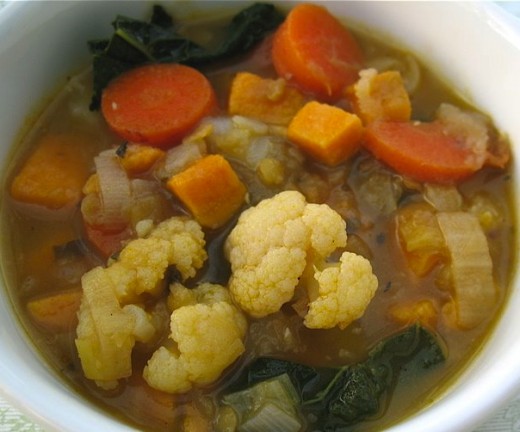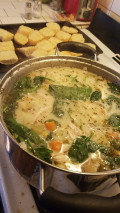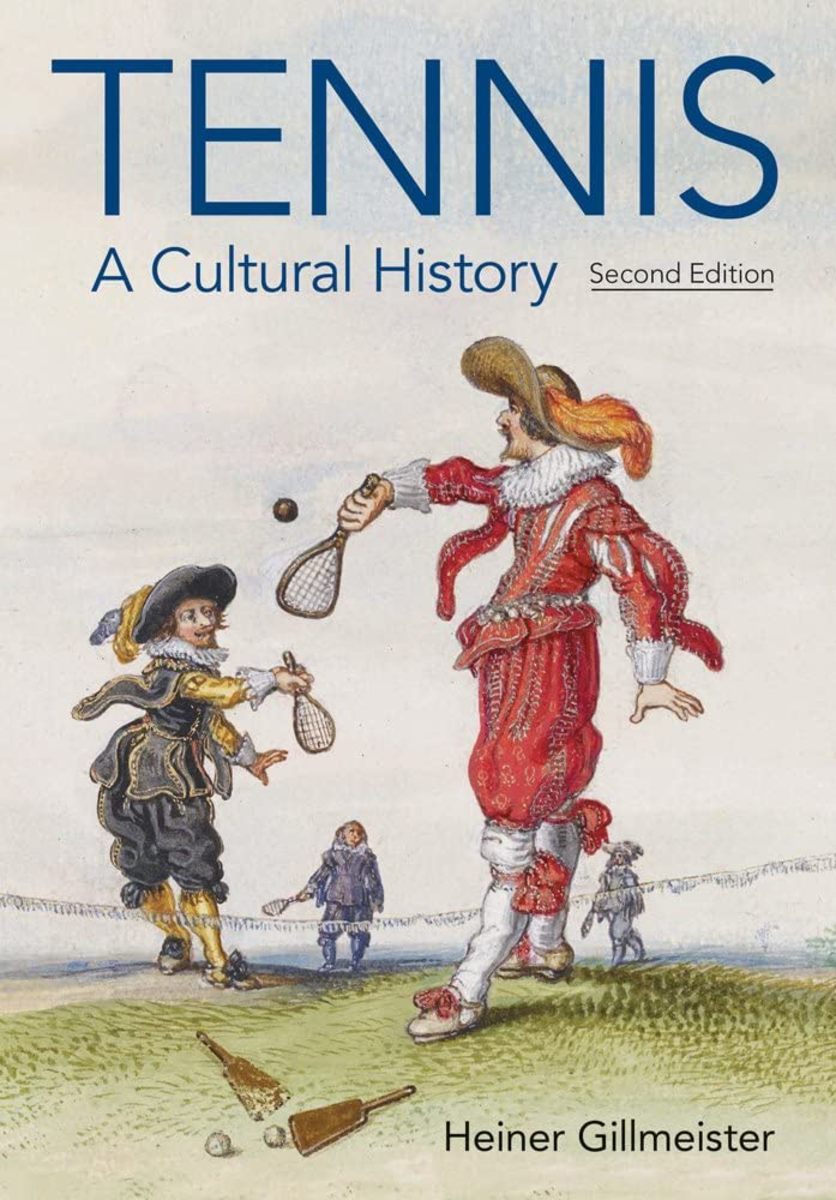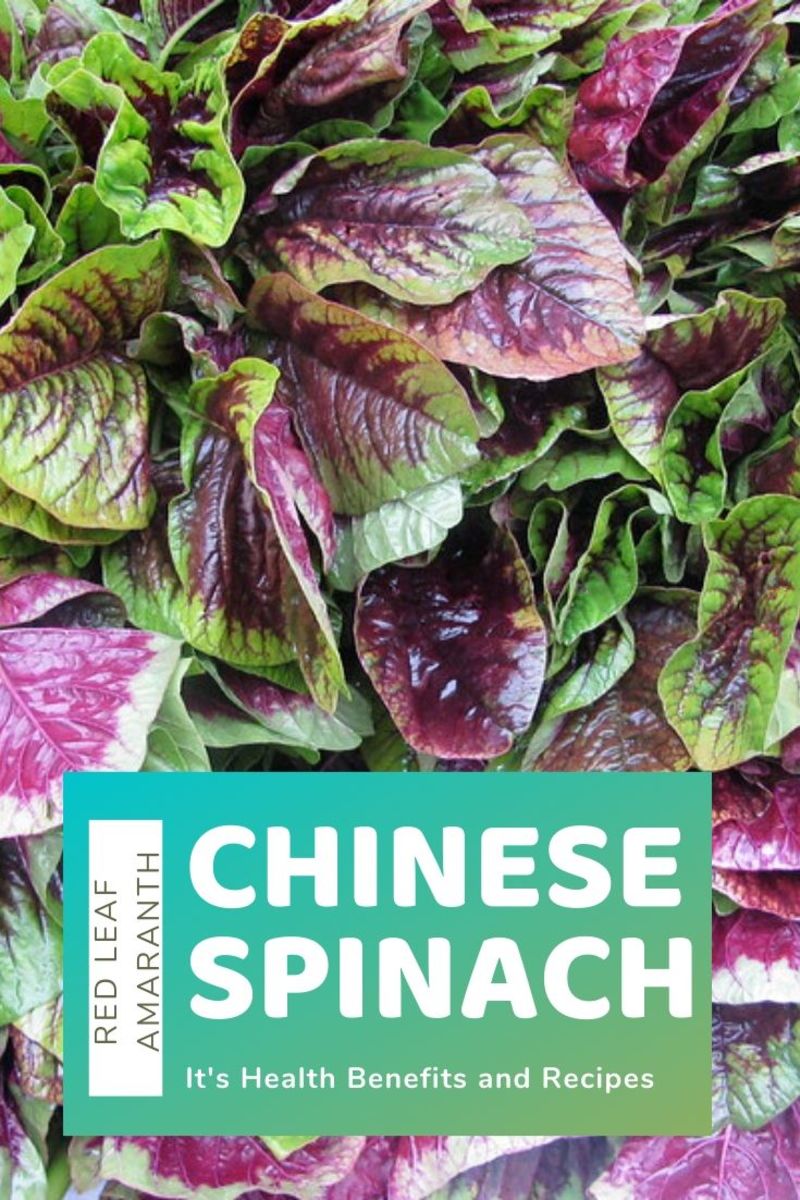Try a delicious medieval broth
Winter harvest Broth

A real harvest broth From ancient Britain
Before you click away from the page, read on you won't be disappointed with the delicious recipe for home made broth at the foot of the hub.
A basic history of the country kitchen
In medieval Britain whole families lived in one roomed huts and kitchens were rare and reserved for the wealthy. People lived in small one room huts where whole families went about their everyday lives. Many of the huts were made of wood and although there was no actual kitchen, methods were found for both heating the house and cooking food. A fire was built in the middle of the room and a small hole was made directly above in the middle of the thatched roof for smoke and fumes to escape.
Cooking implements such as large 3-legged pots made of cast iron fitted over the open fire and were perfect for making soups and stews. Some could not afford the 3-legged pot and made a pot which hung by a piece of rope over a beam from the roof .
No matter which type of pot was used most were able to make a spit which was used for roasting the occasional rabbit or hare. They would also have a drip tray under this to catch the potentially lethal fat drips which were all too often the cause of home fires.
The normal families in medieval times were often called peasants and their diet consisted of white meats, milk products such as cheese,whey, butter, buttermilk and eggs. They also had bread, peas, beans, herbs, apples, cherries and wild berries. If they could get hold of a piece of bacon to their stew it was regarded as a luxury.
Families that were better off would own one or two pigs, when these were slaughtered the offal would be made into sausages and the rest of the meat was cured for ham or bacon.
The curing of meat was important , the carcass of the animal was hung up and smoked. The blood and the fat were pounded together, flavored and mixed with herbs ( sometimes adding a little meat from the underside of the animal ) then packed into it's own gut.
16th Century cooking
In the 16th century homes were beginning to develop and the fires were moved to an outer wall which was then called the hearth. From the hearth ovens were developed and it was here that many new techniques were developed such as baking bread in clay pots.
In the far North of Britain the highlanders and Islanders peasants prepared their own corn with a quern which was a small hand mill consisting of two stone discs one fixed and one that rotated over the other allowing the corn to be ground. In lowland Britain the peasants took their corn to local water mills. It wasn't until the 13th century that windmills were found in Britain.
Salt which was collected from the coastline was an important commodity and found in every kitchen.
From the middle of the 16th century a new middle class began to emerge in Britain. This was due to the up and coming traders, merchants, craftsmen, doctors and lawyers.
In these times it was desirable to live and build homes in the country where many of the wealthy would become squires. Houses would accommodate staff and the kitchen was found near the quarters of the kitchen staff. The kitchen was known as the hub of the house where many activities were carried out by the staff. You could find activities like candle making, rush lights being made as well as hams being smoked and pickles being made. Fruits were also being dried and preserved. Vegetables were also being salted and preserved for the long hard winters.
Herbs were grown and dried to be used for flavoring and developing medicine. Pomanders were made as well as scented bags for cupboard and room fresheners.
By Elizabethan times homes had kitchens with tall chimneys built up from the hearth in the kitchen. The typical spit was now supported on either side of the hearth by cast iron "cup dogs"
These supports were also used to hold cups of soup warm hence the name "cup dogs "
When meat was roasted on the spit the fat would drip down into a long narrow trough and later used for making candles.
A typical broth that was consumed was the harvest broth.
Here is a typical recipe and one that is still loved by many today.
Preparation time is around 30 minutes and cooking time is around 2.5 hours.
900grams Middle knock of lamb ( 2lbs )Cut into cutlets
2.5 litres of stock or water ( 4pints )
Salt
Black pepper
Bouquet garni
6 spring onions chopped
2 carrots peeled and diced
2 small turnips peeled and cubed
175g shelled young broad beans ( 6 ozs )
225g shelled fresh peas (8ozs )
1 small cauliflower divided into sprigs
1 washed lettuce dried and cut into fine shreds
1/4 tsp sugar
2 tsps finely chopped mint
2 tblsps of finely chopped parsley
Trim fat from lamb and place in a heavy based saucepan. Add water or stock and season with salt and pepper. Add bouquet garni and bring slowly to the boil. Skim off all white scum. Cover tightly and simmer gently for about 1 hour. Or when the meat is loosening from the bone. Lift meat out and separate it from the bone and cut into bite size pieces. Discard the bone.
Return the meat and add onion, carrots, turnip beans and half of the fresh peas. Cover and simmer for 45 minutes. Then add the cauliflower and lettuce, remaining fresh peas sugar and mint. Continue to simmer for another half hour until the last vegetables are splitting but not broken. Discard the bouquet garni before serving with hot crusty bread.
If you make this i hope you enjoy it as much as we do.





